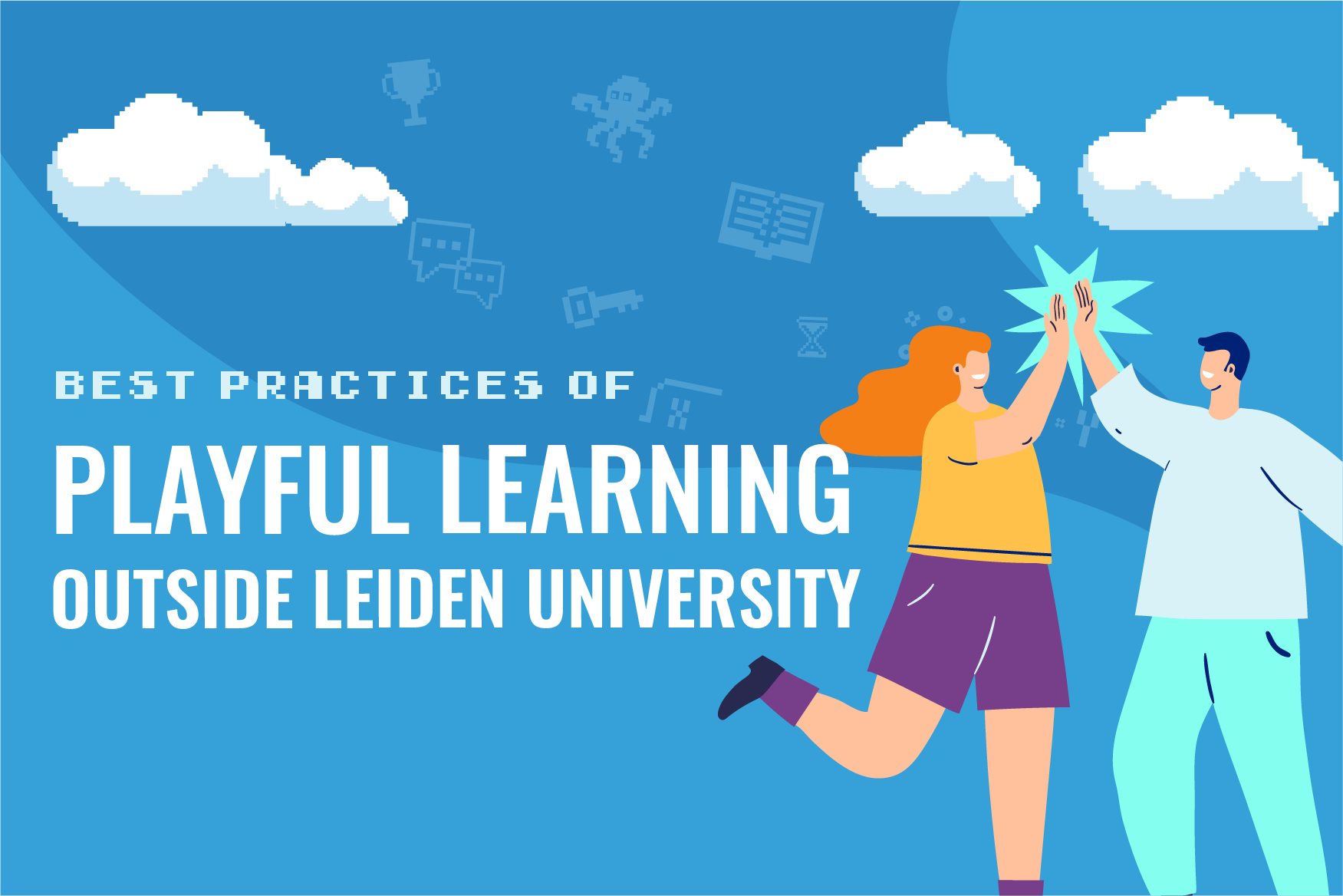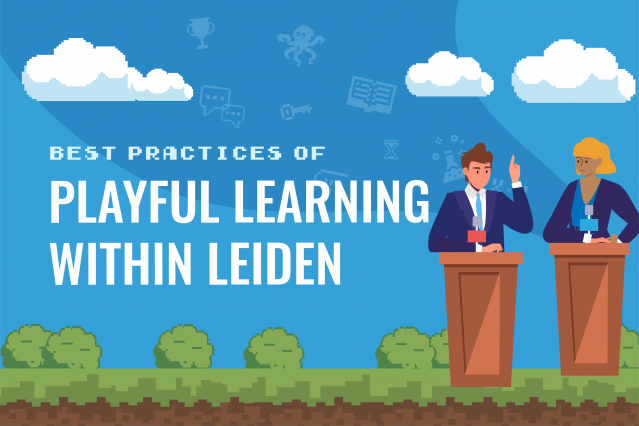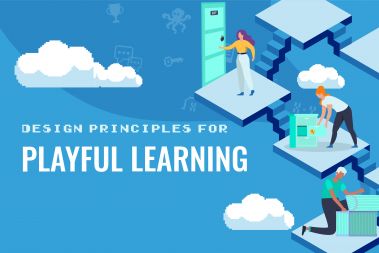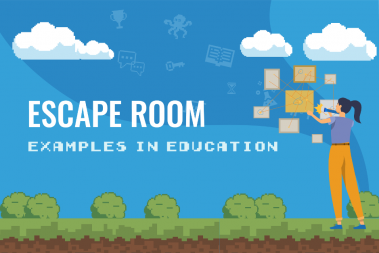Insights
Best practices of playful learning outside Leiden University
In our blog series about playful learning, we already covered the best practices of Leiden University teachers applying playful learning principles in their teaching and best practices of escape rooms in education that are developed by other Dutch university innovators. In this article, we will share some of the best practices of playful learning that teachers outside of Leiden University have developed.
We interviewed several teachers and staff members from Dutch universities and universities for applied sciences to ask how they applyplayful learning in their teaching.

Ludodidactiek & playful testing at Hogeschool voor de Kunsten Utrecht – Evert Hoogendoorn & Willem-Jan Renger
What is the playful experience about?
Ludodidactiek is a design method for teachers on how to implement game design principles in your teaching. It combines educational science, game design, and course design. As the designer, you start with the learners: How should they feel during the experience and what should they do? Once that is clear, you start thinking about the game mechanics. You should also distinguish between the learning objective and the objective of the game. The game objective can help the learners to achieve the ultimate learning objective.
An example of a playful examination is a card game that Evert designed for his course. Originally developed for summative assessment, but now used for formative assessment. During his course, students learn about the relations between educational theories, game theories, games, and gaming elements – many of which are written on the playing cards. While playing the game, students try to connect one of the cards in their hand to the cards that are already on the table. They do this by arguing how these concepts connect to each other. The other players judge if this new card indeed connects to the table cards. Depending on the amount of cards they are able to connect their card to, the students get a certain amount of points. At the beginning of the course, students don’t get a lot of points, due to their lack of familiarity with the different concepts. However, during the course they develop their understanding of the concepts by playing the game alongside the teaching, learning not only from the course content but also from each other. The game can be played multiple times during class, without an actual ‘teaching to the test’ effect, because of the enormous amount of cards and concepts.
How do students experience this playful way of testing?
There hasn’t been a student yet that didn’t like this experience. Once, there was a student who wanted to take the exam at a later moment, because he felt he wasn’t prepared well enough and would lower the level of the other players at his table. Evert allowed him to take the exam a couple of weeks later, but the student had to recruit enough other players for that game. It ended up that his entire class wanted to play the game again because they liked it so much.
What would be your tips for other educators?
- Design yourself out of a learning situation. Create a situation that is motivating and clear for your students, so your role is to watch and guide them. In that way, not everything depends on the teacher.
- Focus on the student experience rather than on the subject matter. Take responsibility for the feelings and emotions of your students.
- Don’t become dependent on teaching material. Nowadays, publishers can take care of everything for you (e.g. creating assignments or revision booklets), but this can reduce your motivation to teach and create new teaching activities.
- You need multiple study domains for the card game to work. This specific type of card game works best if you combine multiple domains because you need to connect different concepts.
- It’s not too difficult to create, but it requires a lot of preparation. The game consists of an Excel sheet, that is turned into cards and send to the printer. If you don’t have experience with game design, designing the game can take quite a while. However, the game can be re-used every year, which saves you a lot of time.
![]()
AbcdeSIM game at VirtualMedSchool – Ronald Nanninga
What is the playful experience about?
Students who study medicine or who go to nursing school need to gain experience in diagnosing and adequately helping patients. This can be done through the international ABCDE approach. In order to give these students extra practice in these skills, they can play the abcdeSIM simulation game. In this game, students will receive a patient in the emergency room (ER) with an undiagnosed problem. With only fifteen minutes on the clock, the students need to analyse the situation, make a correct diagnosis, and make sure the patient is transferred to the correct department.
The game can be used to update doctors’ and nurses’ knowledge and skills during their downtime, or for students to prepare for real-life problems. An added value to this simulation is that students can experience the response to incorrect diagnoses and medication, without it hurting an actual human being. Once the student has mastered the simulation, the score usually begins to drop. This is because the student starts experimenting with the medication: “What effect does this have, and how can I undo it?” This is possible because the patient in the simulation responds in the same manner a normal patient would and increases the learning curve of the students.
There is also a competitive element available. At the beginning of the simulation, the student is asked to fill in a few general questions about their background, after which they will see how they scored on the simulation compared to their peers. It is also possible for different departments to compete against each other.
Lastly, there are slightly different versions available. This is because nurses and doctors are allowed to perform different medical acts, but there is also a version available that focuses on children in the ER or a version that is more focused on General Practitioners. They are currently working on a more adaptive track, in which your score in a previous challenge will impact the difficulty level of the next one.
What are the students’ experiences?
Students who play this game quickly become better, even without having received classes in the material used. So even though students are not taught the materials in a traditional way, they are still able to play the game and become more proficient. The difference between the best and the worst player (or in school, the best and the worst grade) has decreased, showing a higher level of proficiency compared to regular schooling. It does show that the more levels you play, the higher the retention will be. However, once the students have not played the game for over six months, the effect starts to weaken. This is comparable to why CPR certificates need to be renewed every three years.
Another important element of the game is the sound. Even though students would rather turn the sound off or down, it helps give a more realistic impression of what the ER will look like, and is crucial to playing the game.
What would be your tips for other educators?
- Involve content experts. Make sure that you design with the learning goals in mind and that you involve the people who are experts in the content you want to focus on.
- Test, test, test. Ask someone else to test the game for you. Don’t do it yourself, because you will have a blind spot for missing elements due to your involvement in the development process. Do keep in mind that testing takes quite some time.
- Make it sustainable. Think about how and where you want to implement it. Make sure you have enough time to provide support and updates. You might have been able to fund the development, but that doesn’t make it a success.
![]()
Two serious games at Erasmus University Rotterdam – Iris Wallenburg, Martijn Felder, Oemar van der Woerd & Jan-Willem Weenink
What are the playful experiences about?
The Erasmus University Rotterdam applies multiple playful experiences in their educational programmes. One example is the serious game ‘Outbreak of a virus’ for bachelor students studying Health Sciences. It’s compulsory, but not graded. The students gather in a large lecture hall that is divided into different fictitious countries. The students are evenly distributed across the countries and are assigned to different policy or organisational roles, such as the Ministry of Health, advisory councils and representative bodies for healthcare organisations, and professionals or pharmaceuticals.
In their role, they have around 2.5 hours (that represent 30 weeks in the simulation) to decide whether people should be vaccinated for a dooming virus outbreak. The game leaders facilitate students with (among others) distributing news items and interfere if necessary with country-specific measures. After the game is finished, there is time scheduled to evaluate game developments and lessons learned with students and the game leaders. The aim of the serious game is to experience the real-life dynamics of policy making and necessary negotiations during uncertain circumstances. It helps students to apply knowledge and to understand theoretical policy concepts that can be difficult to grasp.
Another example is a simulation game for master students studying Health Care Management about safety and security in hospitals. Participation is mandatory and students have to write a personal reflection essay afterwards. During the first part of the game, the students have to come up with a safety plan for a fictitious hospital within one hour. They play it in groups of six and each team member represents a specific role, such as a representative of the hospital board, medical staff or the facilities department. They have limited budget and can request quotations for different safety measures they can take in their hospital.
During the game, they will receive messages that they may need to act on, for example that the Ministry of Health, Welfare and Sport suddenly has determined that every hospital must have a digital security system. Once the students have submitted their final safety plan, they meet each other in a plenary room. The students think the game is over, but then a disaster occurs (for example, football hooligans that trash the hospital or a terrorist attack). How does their newly constructed safety plan match with the disaster scenario? The hospital board is called for a press conference during which they must explain the hospital’s actions. In total, it takes 4 to 4.5 hours to play the game. After the game is finished, the master’s course continues for a few weeks and the remaining theory can be discussed using the game.
What are the students’ experiences?
The students feel very engaged and experience a lot of emotions. To be successful, it requires a lot of their knowledge. So teachers need to find the right balance between what the students should learn during the game and when it’s too difficult. The students have indicated that these type of games help them to understand the difficult concepts, also the theories and concepts that are discussed after playing the game because they can connect it to their own experiences.
What will happen in a working group is pretty straightforward, but a serious game is not. Possible solutions for letting students participate and preparing them for the game, is to use participation points, to provide them with teasers about the game, and sell it with your own enthusiasm.
What would be your tips for other educators?
- Don’t underestimate the time for and importance of reflection. Reflection is necessary in order to maintain the connection with the students and the overall content of the course. It’s best to do this on the game day itself, so everyone can remember what happened and what tensions there were.
- Connect it to the real world and include practitioners if of added value. What does the situation look like in real life? For example, we always end our hospital game with a talk from a real hospital administrator.
- Don’t do everything yourself. Bring in people with expertise and experiences who know how to make games.
- Make sure you have/invest enough time and money. Teachers are not going to do it in their spare time. They need support, time and money.
Get in touch with the authors

Yentl Croese
Learning Experience Designer
y.croese@sea.leidenuniv.nl
Emma Wiersma
Learning Experience Designer
e.m.wiersma@sea.leidenuniv.nl







